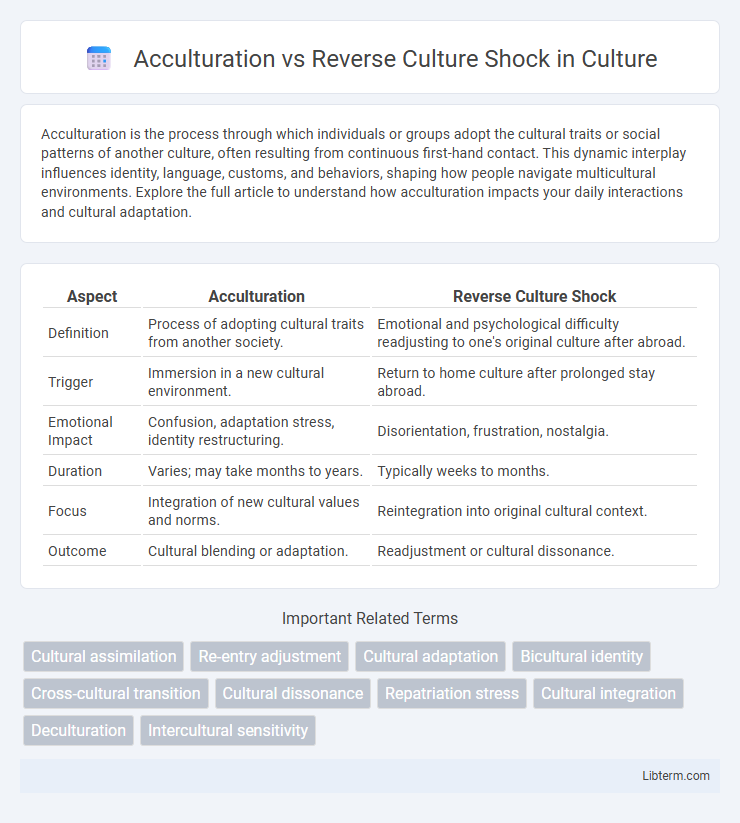Acculturation is the process through which individuals or groups adopt the cultural traits or social patterns of another culture, often resulting from continuous first-hand contact. This dynamic interplay influences identity, language, customs, and behaviors, shaping how people navigate multicultural environments. Explore the full article to understand how acculturation impacts your daily interactions and cultural adaptation.
Table of Comparison
| Aspect | Acculturation | Reverse Culture Shock |
|---|---|---|
| Definition | Process of adopting cultural traits from another society. | Emotional and psychological difficulty readjusting to one's original culture after abroad. |
| Trigger | Immersion in a new cultural environment. | Return to home culture after prolonged stay abroad. |
| Emotional Impact | Confusion, adaptation stress, identity restructuring. | Disorientation, frustration, nostalgia. |
| Duration | Varies; may take months to years. | Typically weeks to months. |
| Focus | Integration of new cultural values and norms. | Reintegration into original cultural context. |
| Outcome | Cultural blending or adaptation. | Readjustment or cultural dissonance. |
Understanding Acculturation: Definition and Process
Acculturation refers to the process through which individuals or groups adopt the cultural traits or social patterns of another group, often occurring when people move to a new country or community. This process involves stages such as cultural learning, adaptation, and sometimes assimilation or integration, impacting language, behaviors, values, and social norms. Understanding acculturation is essential for navigating cultural differences, reducing stress, and promoting successful adjustment in multicultural environments.
What is Reverse Culture Shock?
Reverse culture shock occurs when individuals return to their home country after an extended period abroad and struggle to readjust to the familiar cultural environment. Unlike acculturation, which involves adapting to a new culture, reverse culture shock challenges one's expectations of home, often causing feelings of disorientation, frustration, and alienation. Key symptoms include difficulty reconnecting with family and friends, changes in self-identity, and a sense of loss or disappointment in the home culture.
Key Differences Between Acculturation and Reverse Culture Shock
Acculturation involves adapting to a new culture when individuals move to a foreign country, affecting their behaviors, values, and social patterns. Reverse culture shock occurs when individuals return to their original culture after prolonged exposure abroad, often experiencing disorientation and difficulty readjusting to familiar customs. Key differences include the direction of cultural adjustment--initial immersion versus re-entry--and the psychological challenges, where acculturation focuses on integration into a new society, while reverse culture shock centers on reacclimating to one's home culture.
Stages of Acculturation: Adapting to a New Culture
Acculturation involves stages such as honeymoon, culture shock, adjustment, and mastery, where individuals gradually adapt to new cultural norms and behaviors. Reverse culture shock occurs when returnees face difficulties readjusting to their home culture, experiencing disorientation similar to initial acculturation stages. Understanding these phases enhances support strategies for smoother cultural transitions and identity integration.
The Emotional Impact of Re-entry: Navigating Reverse Culture Shock
Reverse culture shock often triggers intense emotions such as frustration, confusion, and alienation when individuals return to their home country after an extended period abroad, challenging their sense of identity. The emotional impact of re-entry involves navigating feelings of disconnection from familiar environments and relationships, exacerbated by changes within both the individual and their home culture. Effective coping strategies include seeking social support, engaging in reflective practices, and managing expectations to facilitate smoother reintegration.
Factors Influencing Acculturation Success
Factors influencing acculturation success include individual personality traits, such as openness and resilience, which enhance adaptation to a new culture. Social support networks, including relationships with host community members and co-nationals, provide emotional and practical assistance critical to acculturation. Cultural distance, or the differences between the original and host cultures, significantly impacts the ease of cultural adjustment and overall acculturation outcomes.
Common Challenges of Reverse Culture Shock
Reverse culture shock often involves struggles such as feelings of alienation, frustration, and disconnection upon returning to one's home country. Individuals may face difficulty readjusting to familiar social norms and routines that now seem unfamiliar or restrictive. Emotional challenges include identity confusion and a sense of loss as former support systems and environments have changed or no longer resonate.
Coping Strategies for Acculturation and Reverse Culture Shock
Effective coping strategies for acculturation include developing cultural competence through language acquisition, building social support networks within the host culture, and maintaining a flexible and open-minded attitude toward cultural differences. For reverse culture shock, individuals benefit from preparing for re-entry by reflecting on changes experienced during their time abroad, seeking support groups that understand repatriation challenges, and gradually readjusting to their home culture to ease the transition. Both processes require proactive mental health practices such as stress management and resilience building to facilitate smoother adaptation.
The Role of Cultural Identity in Both Experiences
Cultural identity plays a crucial role in both acculturation and reverse culture shock by influencing how individuals interpret and adapt to new cultural environments or their original culture upon return. During acculturation, a strong cultural identity can provide stability and a framework for integrating aspects of a new culture without losing one's heritage. In reverse culture shock, conflicts between evolved cultural perspectives acquired abroad and the unchanged cultural expectations at home often challenge one's sense of identity, complicating reintegration.
Long-term Effects: Personal Growth and Adaptation
Acculturation fosters long-term personal growth by enhancing cultural awareness, emotional resilience, and adaptability through continuous exposure to new social norms. Reverse culture shock challenges individuals upon re-entry to their home culture, prompting reflection and adjustment that can lead to improved self-identity and intercultural competence. Both processes contribute to a dynamic cycle of adaptation, enriching global mindset and emotional intelligence over time.
Acculturation Infographic

 libterm.com
libterm.com